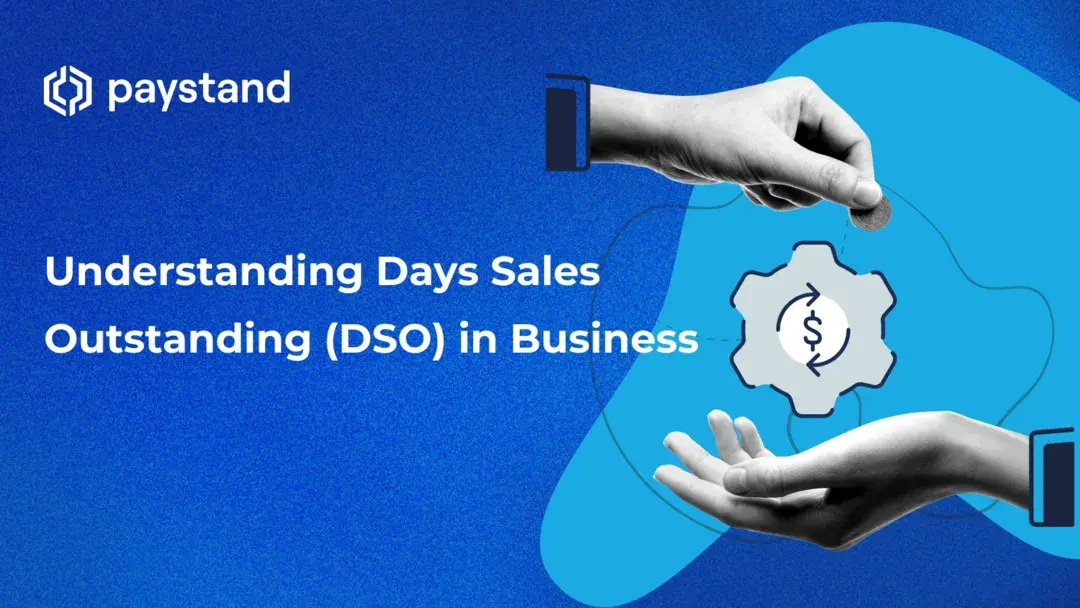Understanding Days Sales Outstanding (DSO) in Business

Table of Contents
- What is meant by days sales outstanding?
- What is the formula for calculating DSO?
- Why is DSO Important?
- How can you reduce DSO?
Key Takeaways
- Days Sales Outstanding (DSO) measures the average time a business takes to collect payment for its credit sales.
- A high DSO indicates cash flow issues, and a low DSO shows efficient receivables collection.
- DSO impacts business liquidity and helps finance teams predict cash flow, reflecting efficient operations and better financial planning.
- On-time receivables can provide the most accurate DSO calculation, while ADD (Average Days Delinquent) helps determine late payment timelines.
- To reduce DSO, businesses can adopt automation, expand payment options, incentivize early payments, personalize collections using AI, and carefully manage high-risk customers.
Understanding how quickly your business collects cash ensures financial health and drives future growth. Days Sales Outstanding (DSO) is a crucial metric that gives businesses insight into how long it takes to convert credit sales into cash. Whether aiming to optimize operations or predict future expenses, grasping the concept of DSO can significantly enhance your accounts receivable management.
Ready to dive deeper? This guide will walk you through everything you need to know about calculating and improving DSO. Using automation and innovative payment solutions, you'll learn practical strategies to streamline your collections, identify uncreditworthy customers, and reduce DSO. Keep reading to ensure your business maintains a strong cash position and is prepared for growth.
What is Meant by Days Sales Outstanding?
Days Sales Outstanding (DSO) is a financial metric that measures the average time a business takes to collect payment for its credit sales. A high DSO can indicate cash flow problems, while a low DSO shows efficient receivables collection.
DSO is affected by payment terms, customer creditworthiness, and billing and collection practices. A low DSO indicates a short collection time, while a high DSO signifies a long collection time.
How Does DSO Relate to Business Operations?
DSO measures the liquidity of a business's current assets. Having readily available capital is crucial for solvency, growth, and expansion. DSO aids finance teams in predicting cash flow and planning future expenses. Monitoring DSO trends over time allows businesses to adjust operations based on available cash flow. A low DSO indicates efficient operations, precise financial modeling, and the potential for scalability.
What is the formula for calculating DSO?
To calculate DSO, divide the average AR balance during any particular time (usually monthly, quarterly, or annually) by the total value of the credit sales during that same period. Then, multiply the result by the total number of days in that period.
Here is the formula for DSO:
DSO = (AR Balance/Total Credit Sales) X Days in the Period
Cash sales are excluded from DSO as they have zero DSO. Including them reduces the accuracy of DSO calculations.
How is DSO Calculated in 3 Months?
To calculate DSO in 3 months, you need to follow these steps:
-
Calculate the average accounts receivable (AR) balance for the three months. Add the AR balance at the end of each month and divide by 3 to do this.
-
Calculate the average daily sales for the three months. To do this, add the total sales for the three months and divide by 90 (the number of days in 3 months).
-
Divide the average accounts AR by the average daily sales. This will give you the DSO in 3 months.
For example, let's say that a business has the following accounts receivable balances and sales for three months:
| Month | AR Balance | Sales |
|---|---|---|
| January | $100,000 | $500,000 |
| February | $120,000 | $600,000 |
| March | $140,000 | $700,000 |
- The average AR balance for the three months is ($100,000 + $120,000 + $140,000) / 3 = $120,000.
- The average daily sales for the three months is ($500,000 + $600,000 + $700,000) / 90 = $6,222.22.
- The DSO in 3 months is $120,000 / $6,222.22 = 19.29 days.
- This means it takes the business an average of 19.29 days to collect payment for its sales.
What is the Most Accurate Way to Calculate DSO?
You can also calculate your best DSO by looking at the receivables paid on time. This will show you the best possible DSO to expect if your business is always paid on time.
Here is the formula for the best DSO:
Best DSO = (Current Receivables/Total Credit Sales) X Days in the Period
If you want to determine exactly how late your customer’s late payments are, you can use average days delinquent (ADD) in addition to your DSO calculations. Calculating your ADD allows you to see how late payments from your customers are at any particular moment.
Here is the formula for ADD:
ADD = Average DSO – Best DSO
Why is DSO Important?
DSO is one of the three metrics used to calculate any business’s cash conversion cycle (CCC). It can be critical for companies that rely on immediate cash flow to survive, especially for small and medium-sized companies that don’t have diversified income streams.
- Decreasing DSO helps finance teams: The shorter the DSO period, the more quickly companies can access their mission-critical revenue and use that money to plan to expand their business.
- DSO can help identify uncreditworthy customers: Finance teams can identify customers late on their payments and implement specific strategies or policies to improve that particular customer’s payment time.
These changes can be made clear to customers through the business’s credit policy or a customer support call or email. To avoid the problem, they should also be communicated effectively to all future customers.
How Can You Reduce DSO?
There are a few different ways to reduce DSO effectively:
- Incorporate automation: Many businesses still rely on paper-intensive and labor-intensive AR processes despite using accounting software. Incorporate AR automation to reduce DSO. Cloud and blockchain payment solutions like Paystand automate invoice sending and instant digital payment collection, eliminating repetitive tasks and handling growing invoice volume.
- Expand payment options and links: To reduce DSO, offer various payment options like credit cards, ACH, checks, and direct bank transfers. Digital flexibility, ease, and speed can encourage customers to pay how they prefer. The Paystand B2B Network provides fee-less bank-to-bank transfers and credit card options with convenience fees. You can shift to payment options that reduce DSO further by offering incentives and an easy payment process.
- Be creative with payment terms: Incentivize early payments with discounts, sneak peeks, or special rewards. Communicate payment terms, early payment benefits, and late payment penalties to shape customer behavior.
- Use AI to personalize collections: ArtificiaI Intelligence (AI) and Machine Learning (ML) help personalize collection processes by analyzing customer profiles and automating collections, leading to lower DSO.
- Let go of high-risk customers: Customers who regularly pay late or not at all are not good for business. Track these customers and use the ADD formula to assess the impact on your bottom line. Consider stopping business with high-risk customers to save time and resources.
As you implement one or more of these initiatives to reduce your DSO, remember that you’ll need to implement continuous training, education, measurement, and recognition to keep your business focused on sustained change. If you’re ready to reduce your DSO by as much as 80%, you can schedule a time to speak with one of our payments experts here or download our Quick Guide to Accounts Receivable Automation.






